RBA Annual Conference – 1991 The Evolution of Financial Deregulation Stephen Grenville[1]
In the five years following the appointment of the Campbell Committee in 1979, the Australian financial landscape was transformed: the banks – the institutional core of the sector – were freed from the restrictions which had hobbled their growth. By 1985, the then-Governor of the RBA could say: “We now have a virtually fully-deregulated financial system.” (Johnston (1985a)). This changed not only the extent and nature of the links between borrowers and lenders, but also altered the way monetary policy impinged on the macro-economy. This paper records the chronology of these changes.[2] The aim is to annotate this by providing context and sorting out which were the crucial changes. To do this, it is necessary to go back well before the appointment of the Campbell Committee, not only to establish the extent and rationale of regulation, but to record that the process of deregulation had begun well before the Campbell Committee first met.
One theme which emerges is that the objectives of the authorities have remained surprisingly consistent throughout the post-War period, but the means by which the objectives were achieved changed over time. These changes were driven by two forces. First, the conjuncture of events and the evolving financial environment which frustrated the achievement of the authorities' goals: in response, changes were made in order to try to meet the objectives. Secondly, the internal dynamic of the deregulatory process which, once begun, developed a life of its own whose logic had to be pursued until the current – largely unregulated – system was achieved. These two themes mean that the process of deregulation has strong elements of inevitability and irreversibility. A further theme which links this chronology together is the evolving intellectual underpinnings of monetary policy, which inevitably influenced the responses of the authorities: the ghosts of Keynes' “defunct economists” were present, as usual, as the deregulatory decisions were taken.
This chronology lends itself to a division into three broad periods. The first takes in the quarter century or so following the War: the regulations created during the War were modified and supplemented in an attempt to improve their potency. This gave way, in the late 1960s, to a recognition that direct regulation was not achieving the objectives satisfactorily, and the decade of the 1970s represents an attempt to move to a freer system. Such were the circumstances of the time that these attempts were largely frustrated: with the failure to establish a less-regulated but still-potent monetary control system, some of the old techniques of direct regulation were, perforce, revived. However, the intellectual framework for deregulation was laid during this decade, with a clear recognition that controlling the shrinking banking sector was not the answer. It had to be replaced by a system which impinged on the whole of the financial sector. By the time the Campbell Committee reported in 1982, the process of deregulation had achieved a “critical mass” and the intellectual climate had undergone a sea-change. The period since 1982 has seen the response of the economy to the newly-deregulated financial sector.
1. A Sketch of the Financial Sector
Deregulation principally concerns banks, but to understand the process, we need to look at the financial sector as a whole, including not only “intermediated” finance, but also direct (non-intermediated) flows.
Goldsmith (1985) has recorded the process of “financial deepening” which takes place as an economy develops a more sophisticated financial sector. Figure 1 shows cross-section data for some 20 countries in 1983. The broad picture confirms Goldsmith's view: new financial institutions develop, providing more specialised financial services and in the process the ratio of financial assets to GDP rises.
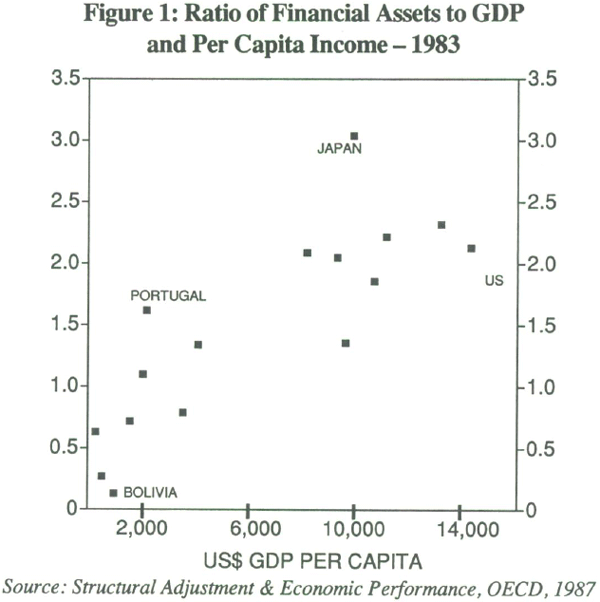
Of the 20 countries reported by Goldsmith, only two showed a decline in the financial assets ratio between 1950 and 1978 – South Africa and Australia. Figure 2 shows the Australian picture (using “liabilities of the non-finance sector”, for consistency with later analysis), which confirms the Goldsmith finding. Government debt dominated the picture in the immediate post-war years. Excluding this, the ratio of financial assets to GDP remained fairly flat until about 1983, and then rose sharply. This same pattern is shown in Figure 3 – the total balance sheets of the financial intermediaries as a proportion of GDP – which provides institutional detail.[3] This illustrates the contracting share of the banks (not just as a proportion of the financial sector, but also as a proportion of GDP) until the early 1980s.
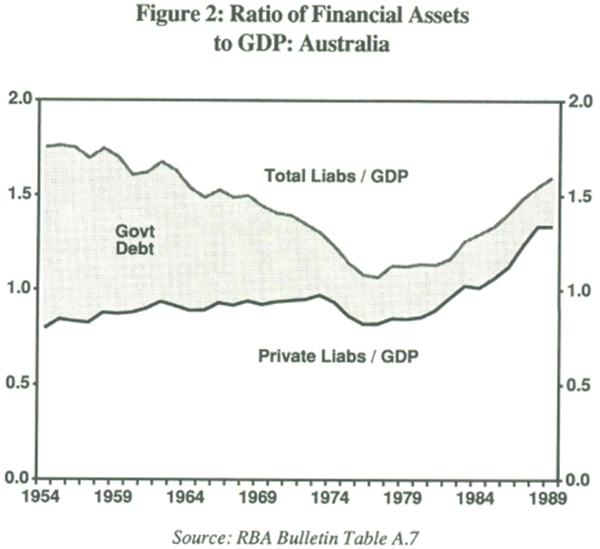
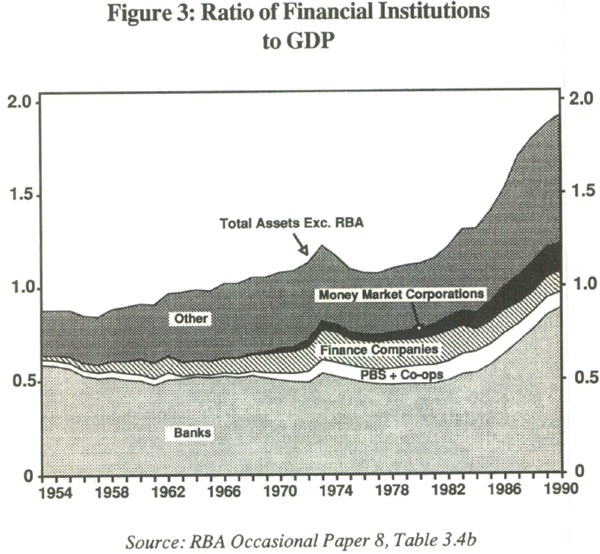
The slow growth of the financial sector (and the declining role of the banks, before 1983) may reflect two factors:
- “financial repression” (McKinnon (1973)). Constraining the banks – the core financial institutions – did not simply result in substitutes taking their place, but left the financial sector as a whole significantly smaller than it would otherwise have been;
- the direct flows between borrower and lender (particularly government debt – see Figure 2) may have been so substantial as to “crowd out” intermediated financial flows.
Throughout the period, the need to meet the government's financing requirements greatly influenced the development of the financial sector.
Australia ended WWII with government debt equal to more than 100 per cent of GDP. This provided an important constraint on the development of the financial sector, by “crowding out” other financial instruments, by limiting me scope for interest-rate flexibility and through the “captive” arrangements whereby financial institutions were required or encouraged to hold government debt. Figure 4 shows the importance of government debt in the balance sheets of the financial sector as a whole, and in the banks' balance sheets.[4] An important theme of the deregulatory story is the gradual removal of this constraint which government funding placed on the financial sector.
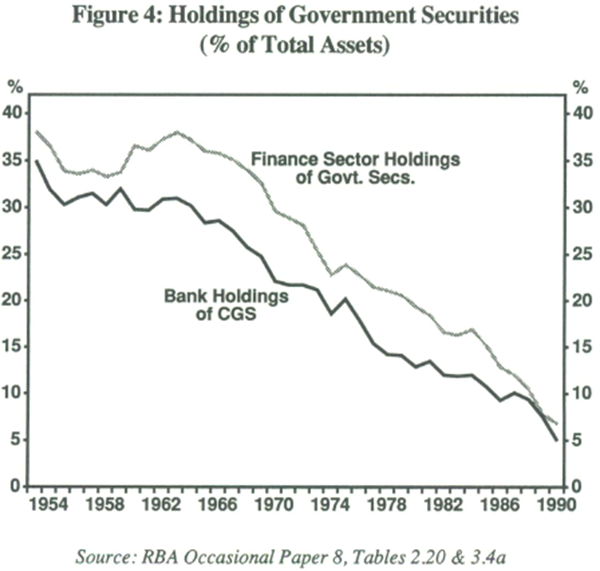
Figure 5 takes the “private liabilities” components shown in Figure 2 (i.e. excluding government), and shows the change each year, again “scaled” by dividing it by GDP. This shows how relatively unimportant was the growth of intermediated finance before the mid 1960s – most of the funding action was in direct borrowing from overseas, equities, and particularly in the residual “other” item, which was mainly direct government loans, particularly for housing. Figure 6 provides further detail of the “credit” component of Figure 5 (i.e. intermediated finance), breaking it down into banks' and NBFIs' credit and bank bills. Explaining the changes, over time, in Figures 5 and 6 will form the basis of this paper.
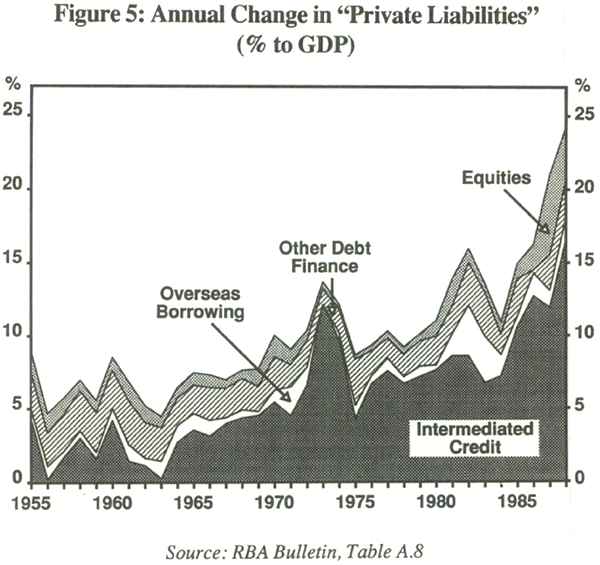
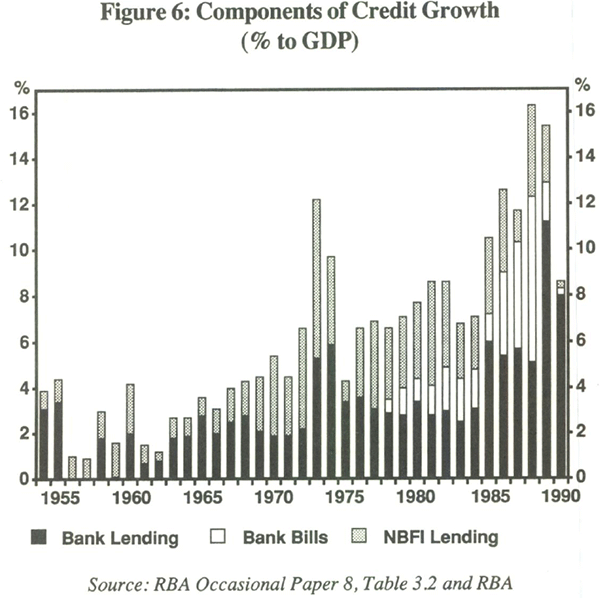
2. Objectives of Regulation
There were a variety of objectives. The authorities wished:
- to influence the pace of the macro-economy through monetary policy;
- to sell government securities;
- to maintain prudential standards (this was achieved as an incidental by-product of regulation until the 1980s);
- to allocate credit to priority areas.
- As well, there was concern about the “euthanasia of the rentier” and a widely-held view that “low interest rates were a good thing”.[5]
3. Period I: Before 1970
This period is of interest not only because it establishes the starting-point for the deregulation process, but because it demonstrates the rationale for the controls. Each of the motives set out in the previous section may have played a part, but the over-riding macro-economic priority was to contain the pent-up expenditure built up during the War, reflected in large liquid balances at the banks. While there may have been a recognition that control could be exercised through an appropriate price (i.e. interest rate) policy, this possibility was not a serious policy option. The intellectual climate favoured a more dirigiste solution. The War-time legacy meant that policymakers began with a presumption that direct controls would be appropriate. This view was given support and intellectual legitimacy by the dominant economic paradigm of the time – Keynesian active macro-management. An active interest rate policy was not favoured for two reasons: few thought that it could do the job; and there were in any case other over-riding constraints on variation in interest rates. The prevailing attitude was probably reflected by Arndt: “Banks have never in modern times relied on the price mechanism to equate supply and demand for bank credit. While higher advance rates could be expected to have some deterrent effect on the marginal borrower – not necessarily the borrower whom it would be most desirable to deter – they could never take the place of credit rationing.” (Arndt (1957, p.211)).
This was combined with the need to “keep faith” with holders of government debt (which at that time amounted to more than 100 per cent of GDP, with around a quarter held by the non-finance public) by avoiding capital losses which interest rate increases would have caused.[6]
(a) The Controls
The response was a complex set of overlapping controls which represented a “belt and braces” approach to constrain the banks' balance sheets without relying on higher interest rates.
- The Special Accounts (later the SRDs) were initially seen as a way of “locking up” or sterilising the excess liquidity which had built up in the banks during the War. Later on, variations in the SRDs came to be used as a substitute for open market operations, varying the amount of liquidity available to banks (and therefore their ability to lend). In the mid 1950s, operating on bank liquidity through changes of SRDs was considered to be insufficiently precise, and this control was made more accurate by the introduction of the LGS ratio. The LGS ratio provided the fulcrum whereby the authorities, using changes in the SRD ratio, would control the size of the banks' balance sheets.
- Limitations were imposed on banks' deposit and lending interest rates.[7]
- There were lending directives, both quantitative and qualitative. The qualitative controls sought to distinguish between “essential” and “non-essential” uses. The authorities gave a clear message that banks should confine their lending to overdrafts and other forms of trade finance or working capital. Credit policy directives issued by the central bank “emphasise that long-term capital for development of new enterprises should be obtained as far as practicable from outside the banking system”. (Commonwealth Bank Annual Report 1949).
- Savings banks were required to hold 70 per cent of their assets in the form of government securities.
- There were extensive foreign exchange controls and a fixed exchange rate.
(b) The Events and Institutional Change
Well before the end of this period, there were precursors of the deregulatory pressures that were to come:
- Banks lost market share.[8] There were no indications of concern that this loss of market share reflected a lack of “competitive neutrality”. Rather, it was a concern because it was seen to weaken monetary policy: “This has meant that the banking system has been becoming a less significant element in the financing of the economy. This is not necessarily a bad thing. … but it does mean that to the extent that monetary policy relies primarily on action through the banking system, it is operating in a steadily contracting field.” (Coombs (1958)). Others also recognised the problems and drew attention to what would later become a central argument for deregulation – the efficiency-cost of a controlled banking system: “the structure of the Australian financial system has been distorted for many years by the concentration of anti-inflationary monetary policy on the control of bank advances. The growth of banks has been held down well below that of the rest of the economy. Many of the services they used to provide are therefore being given instead less efficiently by much higher-cost financiers and other fringe institutions. In order to increase the efficiency of the mechanism as a whole, it was most important to encourage a large expansion of bank advances.”[9]
- There was a recognition that there would have to be greater variability of interest rates for monetary policy to be effective. “Effective open market operations by the central bank in the restraint of inflation are also unlikely unless we adopt more flexible attitudes towards interest rates.” (Coombs (1958)). “For interest rate policy to be a significant instrument of control, however, it would be necessary for rates to be moved more promptly and decisively than we have been able to move them in the past … Political and social attitudes towards interest rates continue to make such flexibility difficult.” (Coombs (1962)).
- Qualitative controls were clearly unpopular, not only with the banks but with the central bank. “Our experience of the operation of the policy (qualitative controls) was not happy. It was a source of irritation between the central bank and the trading banks … Although the policy was a necessary part of an adequate anti-inflationary policy in the conditions of the time, our experience with it suggests that so far as possible a central bank should seek only to determine the general settings within which banks can operate, leaving judgments of individual cases to them.” (Coombs (1954)).
Some action was taken to address these problems. Concern about banks' competitive position led the authorities to alter the balance between SRDs and LGS assets in the mid 1960s to allow the banks to hold smaller SRDs and a larger proportion of LGS (which returned a market-related rate of interest). Various institutional moves were made to ensure the banks could meet a larger proportion of the demand for loans. The Australian Resources Development Bank was set up in 1960. In 1962, the Term Loan Funds began (with interest rates outside the normal ceilings).
But the predominant institutional change of this period was the growth of alternative channels of financial intermediation (Figure 7 takes the pre-1972 data from Figure 6 and provides more institutional detail). The finance companies were the earliest example, driven by post-War prosperity and the controls which prevented banks from providing finance for this sort of “nonessential” purpose. The initial response of the authorities to the growth of finance companies was to limit their sources of funds. Finance companies were forced, by central bank credit directives, to cease using bank overdrafts to fund their advances and instead to issue their own securities. (Coombs (1958)). The hope that these rival financial institutions would not be able to bid funds away from the banks proved to be illusory: the finance companies succeeded in expanding their balance sheets by issuing debentures. This may have prompted the authorities to allow the banks to take larger shareholdings in the rival non-banks, particularly the finance companies. In the 1960s, the building societies stepped into the void created by the requirement that savings banks hold more government securities than housing advances.[10] “The building societies are able to charge and pay higher rates because savings banks have been unable to satisfy the demands for housing finance. … The market has thus intruded through the back door.” (Sanders (1969)). Thirdly, there was the formation of merchant banks. These had diverse roles which changed over time, but an important initial motivation was to meet the demand for investment funds created by the new mineral projects, beginning in the mid 1960s. They had an importance beyond their balance sheet size: they were, with the representative offices of foreign banks, the facilitators of the overseas capital inflows. All three institutional developments were driven by the inability of the banks to meet the demand for finance. Figure 8 shows some (rather crude) measures of how inadequate were the bank funds in relation to expenditures in these three areas: consumer durables, housing, and business fixed investment.
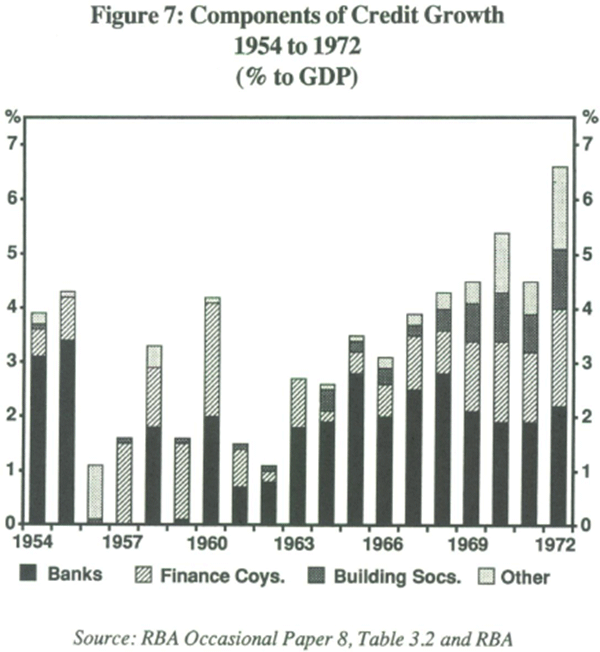
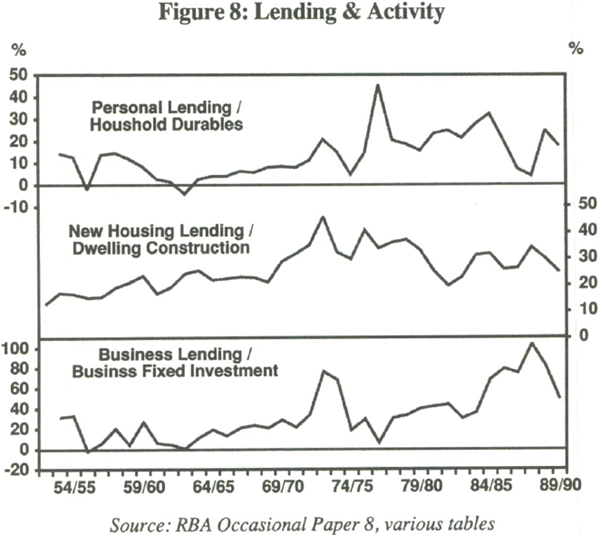
The development of the bank bill market, beginning in the mid 1960s, represents a different approach on the part of the authorities. Faced with the inevitable development of alternative (non-bank) channels of intermediation, the authorities chose instead to keep this within the banking sector, but not subject to the diverse constraints on banks' balance sheets. “… the risk that bill finance would grow rapidly in areas beyond the reach of the authorities appears so serious that inaction cannot be justified … To maintain the relative weight of banks – which are the main channel of official monetary policy – further growth of financing should be retained as far as possible within the banking system.” (RBA (1964)). The business could be kept within the purview of the authorities, but only by refraining from controlling it. It became a sort of “Trojan horse” within the regulated sector, presenting this sector with an opportunity to avoid the regulations. The bill market became the primary channel for, initially, avoiding the interest rate controls and credit directives, and then, in the 1980s, the SRD implicit tax.
One more officially-sanctioned institutional development began at this time: the “official” money market. “This link (the official short-term money market) both gives the authorities more scope to influence markets and brings market pressures more directly to the notice of the authorities.” (Sanders (1969)).
4. Period II: A Tentative Foray into Deregulation
Thus by the late 1960s, the banking sector was under significant pressure from the growth of rival financial institutions and the intellectual climate had changed. The most important factor motivating the re-appraisal was the banks' loss of market share, and the consequent weakening in the potency of monetary policy. “It would be unrealistic to deny that market imperfections enable the authorities to achieve some restraint on total financing through restraint on bank finance – at least for some time. But the Australian financial system has shown its capacity to fill any sizeable prolonged gap left by the banks. We also have to recognise that in relying on market imperfections we are contributing to short-run disruptions and longer-run distortions in financial markets, both of which can result in inefficiencies in the allocation of resources.” (Sanders (1969)).
The response was to look for a more market-oriented method of implementing monetary policy, which the authorities described as “open market operations” but which was, as we shall see, a modest and embryonic affair compared to the open market operations of the 1980s. “We would nowadays tend to look first at the more pervasive instruments of open market operations and interest rates, and then at the direct influence on lending and direct liquidity controls.” (Phillips (1969)). “While direct controls can be a useful help to policy in the short run, they cannot be used continuously in the longer run without support from appropriate market-oriented policies; as time goes on the market tends to find ways around a direct control.” (Phillips (1971)).
The new open market operations were seen as having a substantial advantage over what might be seen as their predecessor – changes in the SRD ratio. “The usefulness of open market operations by the central bank rests on the fact that they can affect the deposits of the public, i.e. the volume of money, as well as bank liquidity.” (Phillips (1964)). Whereas the old system operated very directly, through SRDs, to reduce the banks' excess reserves (over and above their LGS ratio), the embryonic open market operations operated indirectly on the banks' balance sheet (altering their excess reserves if the non-bank public's holdings of bonds changed). This mechanism was weaker than the SRD channel for controlling the banks' balance sheet, but opened up a new transmission channel – the general level of interest rates – which was to become, in the 1980s, the principal transmission mechanism of monetary policy. “To a very large extent, monetary policy now operates on both bank and non-bank intermediaries, and on direct financial flows. In times of excessive spending, increases in administered interest rates can, particularly if they are accompanied by increases in free market rates, be expected to have some direct disincentive (cost) effect on spending on capital goods and consumer durables.” (Arndt and Stammer (1972, p.196)).
As was noted, there was an attempt to redress the loss of market share by the banks. But if the banks' balance sheets would no longer be constrained by direct controls, what would be the transmission channel of monetary policy? For some, greater variability in the general level of interest rates was the transmission mechanism: open market operations would raise interest rates in the overall financial sector, discouraging demand for loans.[11] But for others, it was changes in relative interest rates which were important. The open market operations would, in this view, mainly operate to change the balance between “money”, bonds and the quasi-money liabilities of the NBFIs. “Measures such as open market operations or changes in bank interest rates will affect the yields on various assets. For example, open market sales which increase yields on government securities are also likely to reduce wealth and the quantity of money demanded. There may also be an increase in credit rationing as institutions that are losing funds because of the change in the interest rate structure try to protect their financial position.” (Phillips (1971)). This linked with “monetarist” ideas which were becoming more influential: “there is evidence of a growing body of opinion that the money supply may, after all, have some special significance.” (Phillips (1971)). “Although we have not opted for steady growth in money supply as a wholly sufficient target of policy, we do acknowledge that large fluctuations in that rate of growth can be unsettling.” (Phillips (1971)). By 1976, this had been formalised with the introduction of “conditional projections” for M3. While the monetarist views gave some support to these shifts between financial institutions as the basis of monetary policy, it did not resolve the issue of loss of banks' market share: M3 was controlled by allowing other institutions (including the government – particularly through ASBs) to bid deposits away from the banks, thus continuing to restrict the banks' balance sheet growth.
But there was a greater emphasis on changing the general level of interest rates which would impinge on the whole of the financial sector rather than just the banks. “With a great deal of experience of that up-hill task in the 1950s, the authorities have accepted that it is easier to bring demand for and supply of finance into equilibrium if the price of finance is raised.” (Sanders (1969)). They recognised that to achieve this greater flexibility of interest rates, the constraint of the government securities market would have to be lifted. “Restraint on banks is less likely to be undone by financial expansion through other intermediaries and direct financing if bank deposits are not easily bid away. Moreover, the risk that the central bank will undo its efforts to restrain finance by itself purchasing bonds offered in the market by those (including banks) wishing to obtain funds for spending or lending to the private sector can only be countered if the price at which it deals can be varied in the light of market pressures.” (Sanders (1969)). Governor Phillips foresaw some later problems: “however, if movements of acceptable size (in interest rates) are to be effective, interest rate changes must be implemented before the cumulative processes characteristic of financial booms get underway. Once inflationary factors have really taken hold, small movements in rates are unlikely to have much effect.” (Phillips (1971)).
(a) The Policy Response
The elements in this new approach were:
- a greater readiness to accept changes in interest rates (and capital values) of government bonds. This change was made easier by the reduction in government debt outstanding, which had fallen from more than 100 per cent of GDP in 1950 to around 30 per cent by 1970;
- an easing of credit directives. Quantitative lending controls were suspended in 1971 (RBA Bulletin, December 1971) and no credit directives were given in the following two years;
- banks were allowed to offer market interest rates on some of their deposits, thus opening the opportunity for “liability management”. CDs had been allowed, beginning in 1969 (although it was not until 1973 that the restrictions were sufficiently eased to make these an effective instrument); in 1972, the trading banks were allowed to set their own interest rates on deposits of more than $50,000 and from 1969 the savings banks were allowed to offer market-related interest rates on investment accounts;[12]
- the SRD ratio was reduced. This process had begun in the mid 1960s, but further attempts were made to reduce the SRD ratio in the earlier years of the 1970s (this meant that even with the interest differential between market rates and the SRD rate rising, the implicit tax of SRD holdings did not increase);
- the balance sheet constraints on the savings banks were eased a little – the requirement that they hold 65 per cent of their deposits in the form of prescribed assets (mainly government securities) was modified slightly in 1970, which began a process which continued throughout the 1970s;
- interest ceilings on loans of more than $50,000 were removed in February 1972. Within a short time, this became the dominant form of bank lending, accounting for more than half of bank lending by mid 1974;
- in August/December 1971, the banks were given greater autonomy in their foreign exchange transactions.
(b) The Market Response
Looking back on this second period, many of the elements which are crucial to the subsequent deregulation in the 1980s were put in place in the early 1970s. Not only were open market operations the main focus of the operating system (with interest rates an important transmission channel), but management of the banks' balance sheets had, to a considerable extent, been handed over to the banks themselves. CDs gave them a source of funds which they could bid for (i.e. they could “liability manage”) and a large part of their loans were at unrestricted interest rates. They had, also, the ability to use the bank bill market to carry out intermediation outside the direct ambit of the authorities.
However, this tentative attempt in the direction of deregulation was not carried through. In the second half of the 1970s, credit ceilings were restored and the SRDs were used vigorously in an attempt, once again, to impose direct limits on the growth of the banks' balance sheets. Moreover, the banks did not, in the event, seize the opportunity which had been opened to them to restore their dominant position in financial intermediation.[13] Why was it not possible to carry through the deregulatory process in the 1970s that the authorities clearly thought was necessary? Two separate factors can be identified. First (and most fundamentally), the authorities found that their new market-based operating procedures were not powerful enough to achieve their monetary policy objectives. Secondly, the forces of competition among the banks were not powerful enough (or the incentives not yet right) to turn the banks into dynamic managers of their balance sheets. The first deficiency was clearly illustrated in 1973/74, when the new freedoms allowed banks to increase advances by almost 40 per cent in a single year, and the authorities' attempts to slow this (combined with very volatile overseas influences on liquidity) led to such tight conditions that M3 growth was negative in the September quarter 1974.
(c) Problems with Operating Procedures
Two events (one outside the control of the authorities, the other not) served to make it more difficult to implement a market-based monetary policy:
- there was a much closer integration with the outside world (which brought interest-sensitive capital flows). While this was still the period of fixed exchange rates, exchange rate changes were not infrequent, so expectations about exchange rate changes began to influence capital flows;
- there were large budget deficits in the mid 1970s.
There were important changes to the international linkages at this time. Whereas previously most of the capital inflow had been in the form of equity or long-term flows (usually from a parent to an Australian subsidiary), the 1970s saw the flows become short-term, interest-sensitive and volatile (see Figure 9). This change was influenced by the setting up of representative offices of foreign banks and the money market corporations, and by other attempts at controls. The most notable of these was the Foreign Investment Review Board, which represented a more cautious welcome to foreign equity capital. At the same time, there were limits on foreigners raising capital in the Australian markets. As well, the minerals boom, which began in the late 1960s, required a degree of capital which was not available domestically.[14]

With the exchange rate fixed, when the authorities attempted to tighten policy by selling bonds, this was frustrated by overseas capital inflow which tended to relieve any liquidity shortage and to prevent the authorities from pushing up interest rates enough to achieve their objectives.[15] Thus when there was a substantial improvement in the terms of trade in 1972, there was a very large increase in liquidity from overseas, and no effective method of sterilising it. This extra liquidity allowed the banks, unconstrained at that time by credit ceilings, to increase their advances by almost 40 per cent in 1973/74. Even when the authorities recognised the need for restraint, the large unused overdraft balances prevented the banks from exercising quick and precise control over their advances.
At the same time, while the authorities were prepared to allow interest rates on government securities to rise in response to their open market operations, they had imperfect methods of ensuring that sufficient government securities were sold. Bonds were sold through “cash and conversion” loans, and the authorities had mixed experience in setting interest rates at a level which would ensure that sufficient government debt was sold. Interest rates on primary issues were set by the Loan Council, partly motivated by the need to minimise interest outlays. With interest rates on the primary issue loans set periodically by the authorities, there were constraints on the volume of open market operations which could be done, because this would have meant undermining the primary bond sale process.
This problem was exacerbated by the large budget deficits in the middle of the decade. The influence of these on liquidity was, in fact, much greater than that of the foreign exchange flows (see Figure 10). The inadequacy of the bond-selling procedures was demonstrated by the need to fund a large proportion of the deficit with Treasury bills, i.e. low-interest non-marketable securities which the central bank was obliged to hold. The dominant role of the “captive” holders of government securities created two constraints on using the bond market as the vehicle for altering interest rates: the market was not a sensitive one, with a very muted price signal; and it would have been unfair on these “captives” to change interest rates too much.
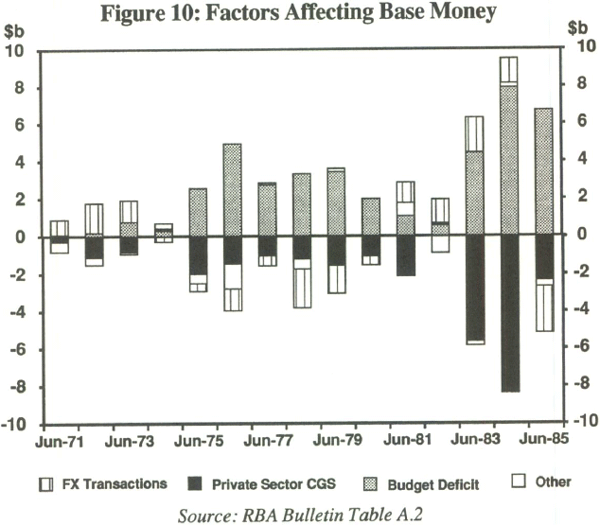
There was, also, a technical problem in using open market operations to control a banking system where the fulcrum of control was a minimum LGS ratio. An open market operation which sold CGS to the banks did not reduce their LGS: only CGS sales to the non-bank public put pressure on banks' balance sheets.
(d) Problems in Banks Managing their Balance Sheets
While the banks were given a fair degree of freedom to manage the liability side of their balance sheets in 1973 and 1974, it is clear that banks at this time did not see this new freedom as a way of enlarging their balance sheets and regaining market share, but rather as a method of short-term liquidity management. The 1974 credit squeeze illustrates this clearly. Banks were able to insulate themselves, to a reasonable degree, from the fall in their time deposits by bidding for CDs, but as soon as this liquidity squeeze was over, the banks allowed their CDs to run off (Figure 11). In terms of short-term profitability, this may have been a correct decision: funds raised at the CD rate, properly costed for the additional SRD obligations and bank administrative charges, were much more expensive than the usual deposit funds, and may not have provided profitable lending opportunities. Perhaps just as important, if the CDs or market-rate time deposits bid funds away from the bank's own low-interest deposits, the true marginal cost of the funds would be very high. “The banks have so far shown little interest in active price competition among themselves, the natural attitude of firms operating under conditions of oligopoly having no doubt been reinforced by three decades of direct central bank control” (Arndt and Stammer (1972, p.208)). The authorities did not assist the banks in their balance sheet management, as they left it up to the banks to manage the very considerable intra-year seasonal variation in liquidity (see Battellino and McMillan (1989)). This continued a long tradition. While the authorities undertook to offset “violent fluctuations” in liquidity, they “left it to the individual banks to meet normal seasonal fluctuations in their control of their LGS assets”. (Coombs (1958)).
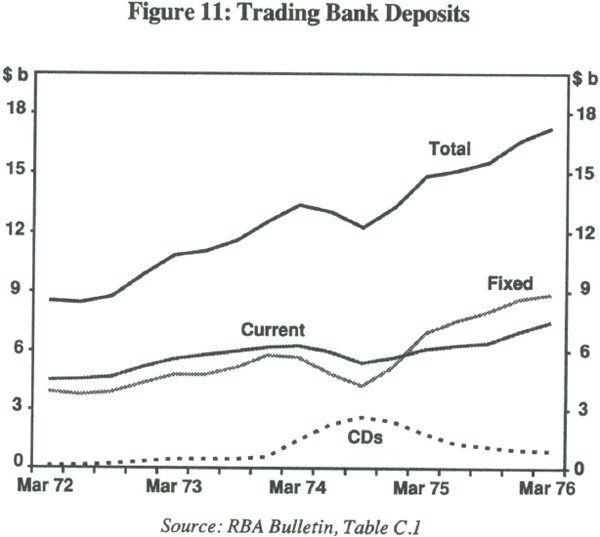
(e) The Response: Partial Return to Direct Regulation
The response, in the second half of the decade, was a partial return to direct controls:
- credit directives were restored in 1976 and were made more specific over the next five years. Between 1979 and 1981, there were specific limits for growth of bank advances, and there was some attempt to give lending directives to the non-banks;[16]
- the earlier attempts to reduce SRDs were abandoned in response to the 1973 credit expansion. The SRD ratio was varied, in the second half of the 1970s, between 3 per cent and 10 per cent. At the same time, the LGS ratio was temporarily raised from 18 per cent to 23 per cent in an attempt to restrain banks' balance sheet growth;
- a Variable Deposit Requirement (VDR) was introduced to help insulate the domestic economy from volatile overseas capital inflow.
These were the technical reasons why the deregulatory process did not develop fully at this time: problems with operating procedures, and a banking system not yet ready to seize the opportunity. Perhaps just as important, there was not yet an unambiguous commitment on the part of the authorities to a market-based monetary operation system. This can be illustrated with a couple of examples. The Financial Corporations Act of 1974 demonstrates that an alternative path was in the minds of some – a path which would address the problem of loss of banks' market share by imposing similar controls on other financial intermediaries. These doubts were reflected in the RBA's 1979 submission to the Campbell Inquiry. “Moderate shifts of emphasis in market operations can then manage the various ebbs and flows in the volume of liquid assets …. However, when there are substantial additions to holdings of liquid assets from the budget or balance of payments, very high rates of interest might be required if reliance is placed solely or mainly on market operations. … Moreover, the impact of general policies on particular groups of institutions may not be quick or substantial. For these reasons the ability to regulate financial intermediaries directly is seen as a needed power.” (RBA Submission No. 8 (1979)).[17] A second example is the use of interest rate relativities to help achieve M3 targets, even when this meant a return to a system whose effectiveness (such as it was) depended on shifting the intermediation process away from the banks to other institutions (for a description of this process, see Macfarlane (1984)). Figure 12 (which repeats Figure 6, with more institutional detail, for the relevant period) shows the banks' relatively modest expansion in the second half of the 1970s compared with the increases in overall financing.
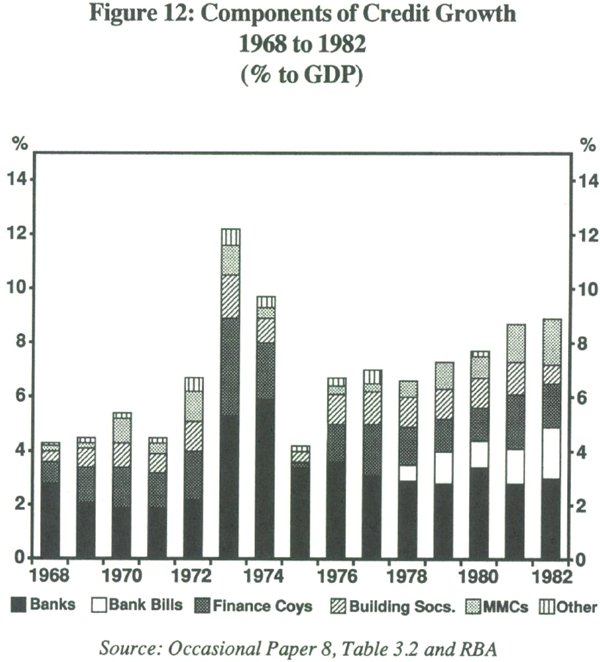
The re-imposition of controls could not, however, be more than a palliative. The old controls had relied on the financial system being imperfectly integrated, so that controls over banks would not simply give rise to this intermediation being done by close substitutes for banks. By the end of the 1970s, the competing institutions existed (including access to overseas institutions), and flows between institutions became very interest-sensitive. The development of NBFIs, the banks' own use of higher interest rates on deposits, and the widely-held ASBs all combined with entrenched inflation to make depositors more interest-sensitive. The mix of advantages and disadvantages that the banks faced had been changed during the 1970s, as competition from building societies (in the market for household funds) and MMCs (for “professional” money) eroded the low-cost deposit funds which had previously been part-and-parcel of the banks' central role in the payments system. So the core institutions in the financial sector were ready for change. Merely to restore the old controls could not provide a lasting solution. Either the logic of the 1974 Financial Corporations Act had to be pursued (and supplemented by more effective controls on overseas capital flows),[18] or a way had to be found to control the balance sheets of all the financial intermediaries through market operations. In choosing between these two possible courses, the decisive factor was the prevailing intellectual climate – in favour of the “market solution”.
5. Period III: Deregulation Achieved
The deficiencies highlighted in the 1970s were:
- constraints on open market operations;
- the foreign exchange flows which hindered the control of liquidity;
- the inability to separate budget funding policy from monetary policy: interest rate changes were constrained by government debt management policies;
- limitations on banks' control over their balance sheets;
- limitations on banks' ability to manage their liabilities because of credit directives;
- the banks were not participants in the deep short-term money market;
- their focus was on managing their own liquidity in the face of big seasonal swings in liquidity.
If controls, such as credit directives, were to be lifted, these deficiencies had to be addressed. In the early years of the 1980s, they were.
(a) Open Market Operations
On open market operations, the changes were:
- with the tender system for treasury notes (1979) and bonds (1982), the budget could be “fully funded” so that it would no longer affect liquidity. Clear understandings were reached, among the authorities, that there would be a complete separation between monetary policy and government debt management. Just as important, the Loan Council no longer set yields, and the RBA no longer had a residual commitment to support the market;
- the float of the currency in December 1983 allowed the authorities to close off one of the channels which had been frustrating their efforts to control the financial system – overseas capital flows. The RBA no longer had an obligation to clear the foreign exchange market, so this source of liquidity disturbance was ended;
- the operating system evolved in two important ways. First, the bond interest rate was no longer the focus of attention. The proximate operating objective became the cash rate, and the link between this and commercial rates (bank bill rates, bank prime lending rates) quickly became very close (see Macfarlane (1984)). Secondly, the RBA acted to smooth intra-year seasonal liquidity fluctuations. With this taken care of, the banks were able to focus their attention on cost-efficient balance sheet management and the expansion of their balance sheets.[19]
(b) Banks' Balance Sheet Management
In 1980, interest rate ceilings on bank deposits were removed and restrictions on minimum and maximum terms of deposits were progressively removed: by 1984 these restrictions were ended. The last credit directive was issued in September 1981 and the system formally ended the following June. The progressive disappearance of the seasonal liquidity pattern (with the authorities compensating, through open market operations, for factors such as tax payments) changed the way banks managed their balance sheets. The diminished role of overdrafts (with the problems presented by their undrawn limits) made this balance sheet management easier.
The response of the banking system was catalysed by a further element – greater competition. The mergers of major banks in 1982 reflect this. The prospect of licensing new foreign banks (even before this was formally done in 1985) forced the banks to turn from asset management towards liability management, competing vigorously for deposits. The foreign banks, if they wished to break into the retail market, had no option but to bid up the interest rates offered on those deposits which had previously paid below-market rates, and the existing banks responded defensively. The effect of this in diminishing the size of non-interest (or low-interest) deposits can be clearly seen in Figure 13.
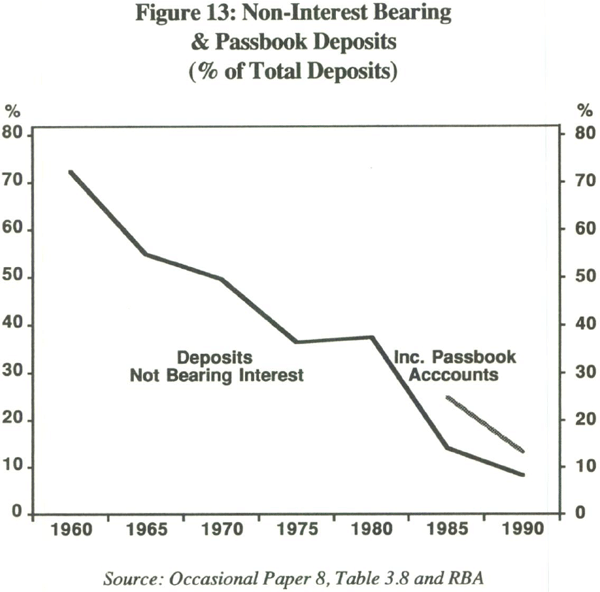
Meanwhile, the institutional changes which had increased competition between other institutions of the financial sector continued, and in the process linked the financial sector together more closely (thus making it even more interest-sensitive). The rise of the cash management trusts (CMTs), beginning in 1980, linked the household sector – for the first time – with the professional money market. These funds grew very rapidly, to reach a peak of around $2½ billion before levelling out at around this level. While the volume of funds in the CMTs was not particularly large, this belies their influence: banks had to respond by offering market-related interest rates on an increasing proportion of their deposits in order to retain them.
By May 1985 the new operating system, based on the cash market rather than the LGS ratio as a fulcrum, had been operating well for more than a year, and the LGS ratio was replaced by the Prime Assets Ratio, which was seen as a purely prudential measure, not to be changed for monetary policy reasons and not to be the fulcrum of the operating system. The PAR ratio was progressively reduced.
The one remaining competitive disadvantage suffered by the banks was removed in August 1988, when the SRD requirement was replaced by a requirement to hold non-callable deposits, much smaller than the SRDs and paying a market-related rate of interest.
The response was that the banks greatly expanded their advances. Initially, a good part of the expansion was in the form of bank bills (see Figure 6). By this stage, the bank bill was not a method of avoiding the deposit and lending interest controls or credit directives, but had the sole remaining advantage of avoiding the implicit tax of the SRD (see RBA (1990)). As would be expected, the banks won back considerable market share. Perhaps more interestingly, the overall amount of intermediation greatly increased. While the finance companies fell in absolute size, and the building societies changed their form through amalgamation and transformation to become banks, the broad picture is that the banks did not win their increased business at the expense of other financial institutions – the new competitive world was one in which the overall financial sector grew very substantially.
What was the reaction of the authorities to this great expansion of financial intermediation? Until the mid 1980s, the authorities saw the greatly increased bank advances as a reflection of “re-intermediation” – banks claiming back their rightful share of financial intermediation from non-banks. The ending of M3 targets in January 1985 was, in effect, an acknowledgment that the channel of transmission was not through any individual aggregate (such as M3, which was being seriously distorted by the deregulatory process), but was through changes in the general level of interest rates operating on the demand for credit, with the division between the various bank and non-bank suppliers of credit determined by the competitive positions of these institutions.
6. Conclusion
Three threads of continuity link the post-War period. First was the desire to maintain monetary policy as a potent instrument of macro-economic policy.[20] Central to this was the control over balance sheet expansion of the banks and (later) the whole of the financial sector. The method by which this would be achieved changed fundamentally during the four decades, but the objective was consistently the same – to influence the financial flows between “surplus units” and “deficit units”.
A second theme is the central – but evolving – role of interest rates in each period. In the immediate post-War period, low and stable interest rates were an objective in themselves – because of anti-usury sentiment, and because flexibility would have imposed capital losses on government bond holders.[21] The importance of interest rate flexibility for effective monetary policy was recognised in the early period, but it was only when interest-rate setting could be passed over to the impersonal market-setting procedures that the necessary degree of flexibility could be achieved. The role of interest rates shifted from purely passive to active – from being held by authorities below market rates; through tentative attempts to free them up in the transition period; and finally, to become the operational focus of monetary policy, with control on banks' balance sheets operating solely through the interest elasticity of the demand for credit. The high rating given to social objectives in the first period was replaced, by the third period, by a belief that “competitive neutrality” would deliver not only economic efficiency, but would achieve some kind of social neutrality, which would allow interest rates to be the centre of monetary policy without being constrained by political imperatives to keep interest rates low. These ideas received powerful support from the Campbell Committee (see Valentine's paper in this volume), which reinforced the old arguments and gave greater emphasis to the market inefficiencies which regulation imposed.
This changing role of interest rates is illustrated in Figure 14. The cyclical variation in the predominant lending rate was less than half a percentage point in the 1950s and 1960s. It was only marginally more in the 1970s, with quite small movements at the time of the 1973/74 “boom/bust”.[22] By the 1980s, policy-induced variation in interest rates during the cycle was around 8 percentage points.
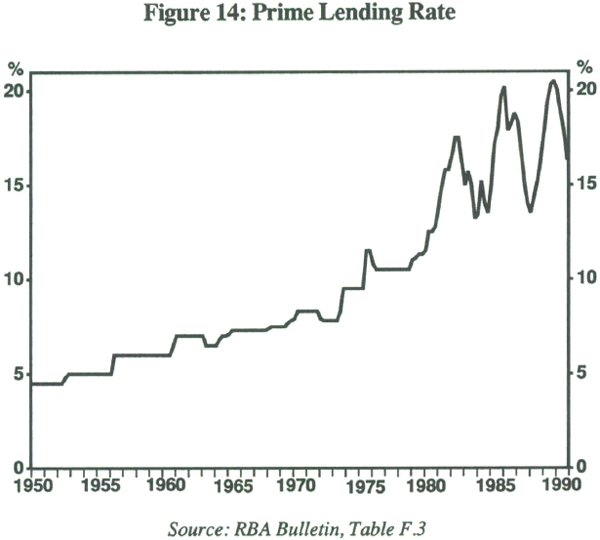
The third theme is the inevitability and irreversibility of the process. This inevitability reflects two factors. First, institutional developments weakened the old methods of monetary control, which relied on market imperfections between the bank and non-bank sectors. When the authorities controlled the banks, there were initially no close substitutes and so the restrictions on the banks worked to control overall intermediation. But as the financial system developed (including access to foreign financial markets), close substitutes appeared (see Harper (1985)). As they became more important, the controlled sector had to be squeezed harder to achieve the overall restraint. But the more it was squeezed, the smaller it would become, and the narrower would be the transmission channels of monetary policy. Secondly, there was an “internal dynamic” to the deregulatory process. As one control on the banks was lifted, this put more pressure on the remaining controls: once qualitative lending guidance was removed, this put more pressure on quantitative restrictions; once deposit interest rates were freed, lending rates also had to be freed so that these higher-cost funds could be profitably lent; once banks could obtain the funds they needed through liability management, then it would have been harder to restrain their balance sheets through credit directives.
The over-riding priority was to maintain (or restore) the potency of monetary policy, and as operational methods broke down, change was necessary. This imperative, combined with an intellectual climate focussing on a market solution, pushed the deregulation process throughout the period, reaching its culmination in the third period. The pace of change was limited by the need to change both institutions and the philosophy – this required time to resolve, and set the timetable of the process of deregulation. Even though many of the problems with the regulated sector were seen as early as the 1960s (and certainly were seen clearly during the 1970s), the mix of institutional and philosophical changes did not occur until the 1980s. The new methods of implementing monetary policy were also dependent on the development of a more sophisticated financial sector. Thus the increasing sophistication of the financial sector created both the need and ability to use more sophisticated versions of monetary policy instruments, relying less on direct controls.
It is not possible to identify one single, critical element in the process of deregulation. Because the old system of controls had contained overlapping elements of control (the “belt-and-braces” approach), the removal of one restriction did not necessarily achieve effective decontrol. But three changes could be highlighted. Given the considerable progress that was made in decontrolling the banks in the early part of the 1970s, it is tempting to argue that the credit directives were, for all their imprecision, very important in the second half of the 1970s and the early part of the 1980s in restraining the growth of banks' balance sheets. Thus their removal, in 1982, was important. In moving to a regime in which changes of the interest rate were central to the operations of monetary policy, clearly the critical breakthrough was the tender system for government securities (1979 and 1982). And in closing off the large flows of foreign exchange which had frustrated the authorities' attempts to control liquidity (particularly in the early 1980s), the floating of the exchange rate (December 1983) was clearly very important.
How should the sharp rise in the role of financial intermediation in the 1980s be interpreted? All the evidence is consistent with the view that there had been “financial repression” in earlier periods. The sharp rise in overall intermediation in the 1980s indicates that the substitute forms of intermediation which developed in earlier periods had not been perfect substitutes for bank intermediation. The fact that the substitutes did not disappear (and, with the exception of the building societies and the finance companies, actually grew further) provides further evidence of a “repressed” financial sector prior to the 1980s. Nor was access to foreign markets a perfect substitute for a decontrolled domestic financial market – the continuing “seasonality” in liquidity and interest rates, which persisted until deregulation, is evidence that overseas flows were not able to substitute perfectly for liquidity changes. The rapidity and nature of the expansion of the financial sector between 1984 and 1989 (shown in Figure 3) was, of course, influenced by a variety of factors. But the pattern of financial development over time shown in this graph is consistent with the sort of “financial repression” described by McKinnon (1973) – the failure of the financial assets ratio to rise over the pre-deregulation period; the upward “spike” in 1973, reversed by the re-imposition of direct controls and the continuation of the ratio at its new higher level even after the first flush of deregulatory ardour had cooled in 1990.
Footnotes
Head of Economic Analysis, Reserve Bank of Australia.
Special thanks are due to those colleagues at the RBA whose comments on earlier
drafts helped to clarify and correct this paper. The usual disclaimer applies.
[1]
The detailed events are set out in the Appendix of Battellino and McMillan (1989). [2]
The institution-based data give a slightly different picture, as the “layering” of the financial sector – inter-institution holdings – is recorded differently and direct financing transactions (e.g. equity raisings) are excluded. [3]
For banks, the graph shows holdings of Commonwealth Government Securities; for all financial institutions, it includes not just CGS, but debt of local governments and semi-government authorities. [4]
This is reflected in Coombs' comment: “We may need to be bolder in seizing opportunities to reduce interest rates if our development is not to be hindered by excessive capital charges.” (Coombs, 1958). [5]
Two quotes will give the flavour of the time. “Thus, by the end of the War, belief in low interest rates had almost become a dogma. This, together with the knowledge that the many who had for the first time during the War become bond holders would be unlikely to understand the normal market fluctuations in the prices and yields of government securities, made interest rate stability at the low War-time rates an important objective of post-War policy.” (Coombs, 1954). “A continuing policy of low interest rates seemed essential. It was doubtful if variations of interest rates could be a powerful instrument for controlling booms and depressions. On the other hand, our obligations to bond holders made it imperative not to let the price of bonds fall much below parity. Control of interest rates so far as possible is therefore very desirable.” (Giblin, quoted by Arndt (1957, p.211)). [6]
It is interesting to speculate on the thinking behind these controls. The limitations on lending rates were, at least partially, motivated by anti-usury sentiments. They also allowed the Government to sell its own debt at lower cost. But preventing banks from offering interest on current deposits may have had some prudential basis, to stop “unhealthy” competition between banks for deposits which might not only push up the cost of funding loans but might also threaten banks' profitability. Even into the 1970s, a mix of considerations was still important: “an important motive of the authorities for the retention of control of bank interest rates has undoubtedly been to maintain the competitiveness of government security yields. But the setting of maximum interest rates on fixed deposits may also reflect the view that price competition between the banks for deposits would lead to very high rates of interest on advances, disadvantaging borrowers, and, perhaps, threatening full employment” (Arndt and Stammer (1972, p.178)). There may also have been some theoretical notion of a distinction between money (non-interest-earning) and near-money (interest-earning), with monetary policy operating on the relative returns on these two types of financial assets. [7]
This is most dramatically illustrated by a comparison with the pre-War position of the banks as substantial recipients of time deposits (which made up 60 per cent of their total deposits before the War: see Arndt (1957)). [8]
R.F. Henderson, “Monetary Policy in Australia 1960/61”, Economic Record, September 1961, quoted in Arndt and Stammer, (1972, p.204). [9]
Their growth was assisted by the provision, starting in 1958, of housing mortgage insurance. [10]
By this time there was much greater integration between the various sectors of the financial market, so that central bank action in the bond market was passed through to the general level of interest rates: “The changes in bank interest rates and bond yields in March and April (1970) were rapidly transmitted through the various financial groupings. The speed and extent of this process owed something to the normal seasonal tightness of funds; however it also owed much to the development of more competitive and interdependent financial markets over recent years, suggesting that there may be more scope for greater flexibility in the use of open market operations.” (RBA Annual Report, 1969/70, p.30) [11]
Banks were still constrained from offering interest rates on short-term deposits. One suggestion of the motivation of this is: “an earlier object of the 30-day rule appears to have been to protect dealers in the official short-term money market from trading bank competition.” (Amdt and Stammer (1972, p.206)). [12]
The authorities clearly hoped that these changes would restore the competitive position of the banks. After noting (in 1969) that some interest constraints had been lifted from the trading banks in order “wherever possible, to permit banks to compete more effectively with other intermediaries”, Sanders commented “the change in the approach to trading banks has had marked effects. Trading bank deposits have almost doubled since June 1960. The share of trading bank assets … has been fairly stable since 1961.” (Sanders (1969)). This did not prove to be the case: the banks went on losing market share in the 1970s. [13]
One measure of the greater international financial integration is that the flows became increasingly two-way: between 1959 and 1969, the average ratio of private inflows to outflows was 20:1 in the period 1969/70–1976/77, this ratio fell to 5:1, and fell further to 2½:1 after 1977. [14]
The standard fixed-exchange-rate textbook model illustrates the extreme version of the case: in it, it is not possible to have an independent monetary policy. [15]
“The Bank reminded (the FCA companies) that policy called for restraint in their lending.” RBA Annual Report 1978/79. For an interpretation of the stance of credit directives, see Davis and Lewis (1978, p.34). [16]
Even so, the RBA clearly wanted more freedom to move interest rates: “Community pressure has been a powerful force towards maintaining control over bank interest rates – probably to the disadvantage of both banks and the community generally” (RBA Submission, No. 9, 1979). [17]
Note the large influence of foreign flows in the early 1980s, recorded in Figure 5 and Figure 10. [18]
In responding to the volatile conditions of 1982/83, the Reserve Bank demonstrated a much greater willingness (and ability) to use open market operations to offset the large swings in system liquidity (see, e.g. RBA Annual Report 1982/83, p.17). The Bank came to use this ability more routinely. [19]
Perhaps the main change in the priorities set out in Section 2 is that prudential aspects – which had been very much in the background in the first period – came to be seen as being very important by the third period. [20]
“But anyone who recalls the hysterical response in press and Parliament to the first tentative moves to unpeg interest rates will remember that such a course was not practicable in the political and social context of the time. A long period of intellectual reappraisal and controversy was necessary … before such a course would become an acceptable alternative” (Coombs, (1969)). [21]
The bank bill rate moved much more at that time, but this was not a policy-induced change (nor was it an important lending rate). [22]
References
Ackland, R. and Harper, I.R. (1990), “Financial Deregulation in Australia: Boon or Bane?”, Conference on Microeconomic Reform in Australia, September.
Arndt, H.W. (1957), The Australian Trading Banks, Cheshire, Melbourne.
Arndt, H.W. and Stammer, D.W. (1972), “The Australian Trading Banks”, Cheshire, Melbourne.
Battellino, R. and McMillan, N. (1989), “Changes in the Behaviour of Banks and Their Implications for Financial Aggregates”, Reserve Bank of Australia Research Discussion Paper 8904.
Commonwealth Bank of Australia (1949), Annual Report, Sydney.
Coombs, H.C. (1954), “The Development of Monetary Policy in Australia”, ES&A Research Lecture, University of Queensland, September 1954.
Coombs, H.C. (1958), “Conditions of Monetary Policy in Australia”, R.C. Mills Memorial Lecture, University of Sydney.
Coombs, H.C. (1962), Sir John Morris Lecture, April.
Davis, K. and Lewis, M. (1978), “Monetary Policy” in Gruen, F.H. (Ed.), Surveys of Australian Economics, Allen & Unwin, Sydney
Dewald, W.G. (1967), “The Short-Term Money Market in Australia”, ES&A Research Lecture, University of Queensland, August.
Goldsmith, R.W. (1985), “Comparative National Balance Sheets”, University of Chicago.
Hall, M. (1987), Financial Deregulation: A Comparative Study of Australia and the United Kingdom, MacMillan.
Harper, I.R. (1985), “Why Financial Deregulation?”, ANU Discussion Paper No. 132.
Holmes, A.S. (1972), “Monetary Policy in Economic Management”, Economic Papers, January/June.
Holmes, A.S. “Some Developments in the Australian Financial System Since 1937”, Economic Papers No. 39, February.
Johnston, R.A. (1985a), “Monetary Policy – The Changing Environment”, T.A. Coghlan Memorial Lecture, University of New South Wales, May.
Johnston, R.A. (1985b), “The Monetary System in Transition”, R.C. Mills Lecture, University of Sydney, October.
Kane, E.J. (1980), “Accelerating Inflation, Regulation and Banking Innovation”, Issues in Bank Regulation, Summer.
Macfarlane, I.J. (1984), “Methods of Monetary Control in Australia”, paper presented at Massey University, August. Reprinted in D.J. Jüttner and T. Valentine, (eds.) “The Economics and Management of Financial Institutions”, Longman Cheshire, 1987.
McKinnon, R.I. (1973), Money and Capital in Economic Development, Brookings, Washington.
Perkins, J.O.N. (1989), The Deregulation of the Australian Financial System, Melbourne University Press.
Peters, R.W. (1987), “The Commercial Bill Market in Australia”, CEDA Study, Longman Cheshire.
Phillips, J.G. (1964), “Recent Developments in Monetary Policy in Australia”, ES&A Research Lecture, University of Queensland, October.
Phillips, J.G. (1969), Interview, The Banker, December.
Phillips, J.G. (1971), “Developments in Monetary Theory and Policies”, R.C. Mills Lecture, University of Sydney, April.
Porter, M.G. (1977), “The Australian Monetary System in the 1970s”, Proceedings of a Conference, October.
Reserve Bank of Australia (1964), “Commercial Bill Market – 1964 Review”, reprinted in Reserve Bank of Australia Bulletin, August 1988.
Reserve Bank of Australia (1979), Occasional Paper No. 7, “Submissions to the Committee of Inquiry into the Australian Financial System”, December.
Reserve Bank of Australia (1981), “Bill Financing by Australian Banks”, Reserve Bank of Australia Bulletin, September.
Reserve Bank of Australia (1988), “Bank Bills”, Reserve Bank of Australia Bulletin, August.
Reserve Bank of Australia (1990), “Recent Trends in Financial Aggregates”, Reserve Bank of Australia Bulletin, October.
Reserve Bank of Australia, Annual Reports, various issues.
Sanders, D.N. (1969), “Australian Monetary Policy: Recent Development and Current Thinking”, Reprinted in Nevile, J.W. & Stammer, D.W., (Eds.), Inflation and Unemployment, Pelican.
Stammer, D.W. and Valentine, T.J. (1983), “Inflation and the Financial System”, in Pagan, A.R. and Trivedi, P.K., (Eds.), The Effects of Inflation, Australian National University, Canberra.